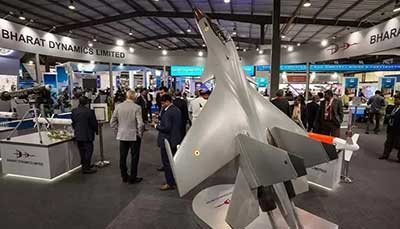Date: 14/11/2022
Relevance: GS-3: Security: Defence infrastructure development, challenges to internal security, Achievements of Indians in science & technology; indigenization of technology and developing new technology.
Key Phrases: DefExpo 2022, Self-reliance in defense, Challenges and problems in India’s defense sector, Defense Imports and exports, Military expenditure, Indigenization of defense manufacturing,
Context:
- In the recently held DefExpo 2022 in Gandhinagar, Gujarat the Prime Minister of India called for the need of India to acquire the appropriate degree of “aatmanirbharata” (self-reliance) in the defence sector.
Key Highlights:
- DefExpo had an India focus i.e. only domestic Indian entities were allowed to participate.
- The Prime Minister asserted that “Make in India '' is becoming a success
story in the defence sector.
- Indian defence exports have grown eight times in the last five years.
- India is exporting defence materials and equipment to more than 75 countries of the world.
- In 2021-2, defence exports from India reached $1.59 billion (about Rs 13,000 crore).
- Although the GoI has now set a target of $5 billion (Rs 40,000 crore) which will require mission-mode resolve to realize this.
Do You Know?
- According to the latest data published by Stockholm
International Peace Research Institute (SIPRI).
- The world military spending continued to grow in 2021, reaching an all-time high of USD 2.1 trillion despite the economic fallout of the pandemic.
- The five largest spenders in 2021 were the US, China, India,
the UK and Russia.
- These 5 countries accounted together for 62% of expenditure and the US and China alone accounted for 52%.
- India’s military spending of USD 76.6 billion ranked third
highest in the world.
- This was up by 0.9% from 2020 and by 33% from 2012.
Defense sector is plagued with many problems
- Although India aspires to become a $5-trillion economy but faces many national security inadequacies.
- The high dependency index on foreign suppliers (traditionally the
former USSR now Russia) for major military inventory items.
- This dependency induces a macro national vulnerability and dilutes India’s quest for meaningful and credible strategic autonomy.
- The current gaps in combat capacity expose the chinks in the Indian ability to safeguard core national security interests. For e.g.- Galwan issue with China.
- Unexpected exigencies such as the Russian invasion of Ukraine , Covid-19 pandemic, weakening rupee that disrupted the global economy and related supply chains, further exacerbated challenges faced by the Indian defense manufacturing ecosystem.
- Private manufacturers lack the incentive to make investments into the sector considering risk on returns.
Recent Defense efforts towards indigenization
- The commissioning of the indigenously-designed and built aircraft carrier INS Vikrant.
- The firing of an SLBM (submarine-launched ballistic missile) from the INS Arihant.
- To award the manufacture of a military transport aircraft (C 295) to a major private sector entity.
- The induction of the made in India Prachand LCH (light combat helicopter).
- The 155-mm artillery guns are being designed and manufactured in the country.
- India-Russia deal to manufacture a Kalashnikov-type light weapon/small arms in India.
What are the major challenges in indigenization of the defense sector?
- India does not yet have the domestic competence to fully design and manufacture any significant combat weapon/platform.
- It is dependent on the foreign supplier for the critical components
that lie at the core of the combat index of the equipment.
- For illustration: India is going to manufacture the C295 transport aircraft in a collaboration with AirBus, France.
- In reality the engine, avionics, landing gear, etc, will come from abroad and the integration will be done by the Indian entity.
- Lack of enough investment in the national research and
development (R&D) for indigenization of defense equipment.
- As per World Bank data India allocated about 0.66 percent of GDP (2018) towards R&D in the defense sector while the world average is 2.63 per cent.
- India is way behind from the comparable individual R&D allocation (percent of GDP) for some other nations: Israel 5.44; USA 3.45; Japan 3.26; Germany 3.14; China 2.4 etc.
- Narrow Private Participation:
- Private sector participation in the defence sector is constrained by the lack of a conducive financial framework.
- Our defence production is unable to benefit from modern design, innovation, and product development.
- National security as a means to lure voters
- Over the years governments have used national security as a tool for political gains and Composite combat and manufacturing capabilities have not been reviewed and honed appropriately.
Way forward
- Providing a sustained fillip to the national R&D efforts
- The Cabinet Committee on Security (CCS) needs to take initiatives which focus on R&D in defense across the board (state, corporate and academia) because it remains critical if India is to emerge as a credible military power.
- India should focus on all categories of defense manufacturing and exports vis-a-vis the present inventory of the “soft” category exports (clothing, helmets, and surveillance equipment).
- It is necessary to extend dedicated defence industrial corridors across the length and breadth of the country in order to harness and channel the potential of Indian MSMEs and DPSUs in the defence manufacturing sector.
- Leverage Indian brains to design and manufacture the semiconductor chips, which are critical for national prosperity and military power.
Conclusion:
- India could not reap benefits out of the industrial design and manufacturing revolution since the 1970s like the way South Korea and China have done
- Presently the Indian brain power is very visible in the global semiconductor/chip fabrication efforts.
- So there is a need to change this techno-strategic landscape in India’s favour and at the same time meaningful indigenization and credible “aatmanirbharta” calls for sustained funding support, fortitude and an ecosystem that will nurture this effort.
Source: Indian Express
Mains Question:
Q. Self reliance in defense sector is the key to India’s strategic independence and autonomy, Discuss.(150 words).








